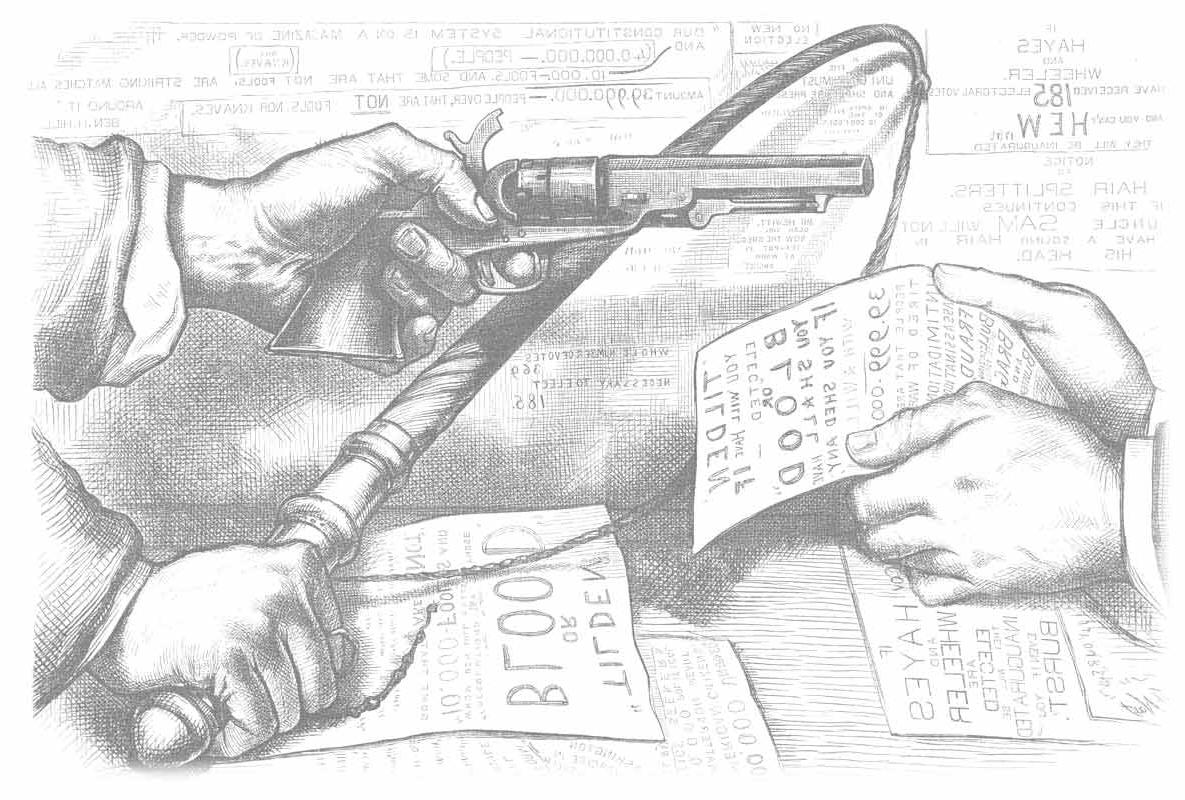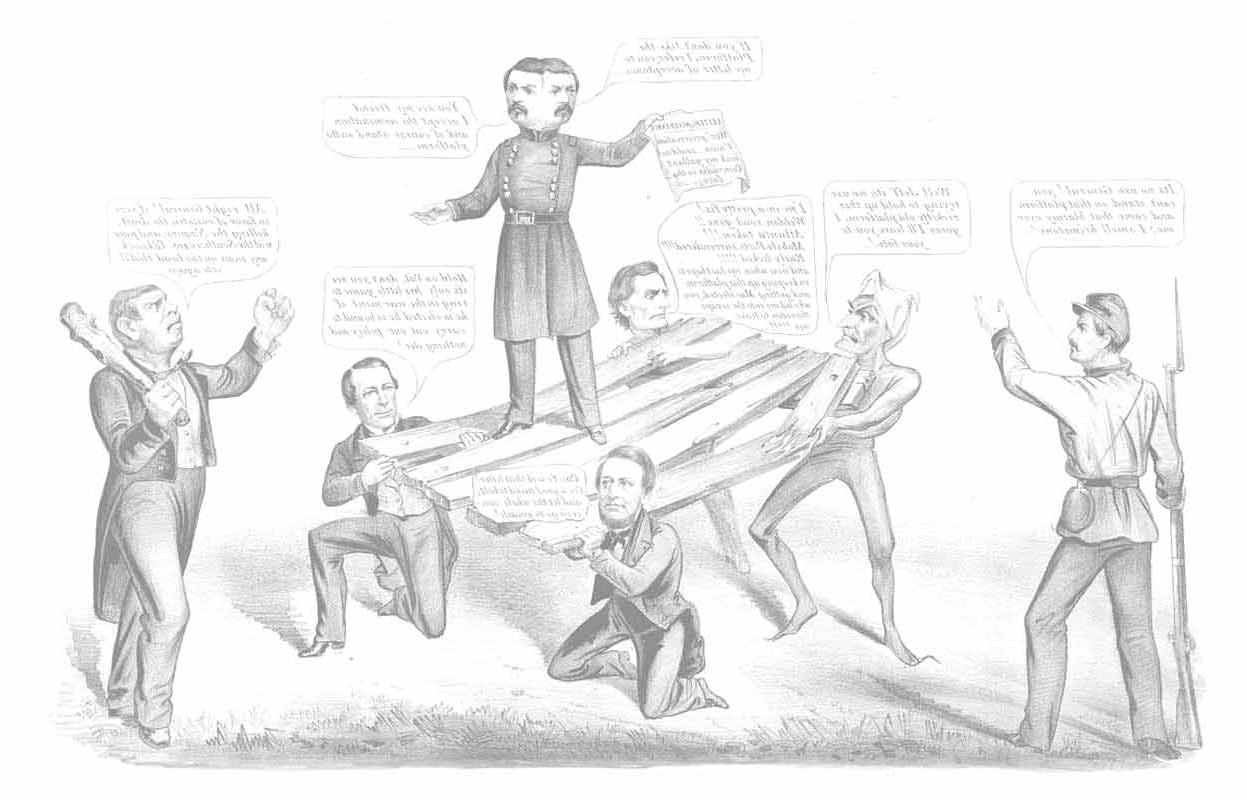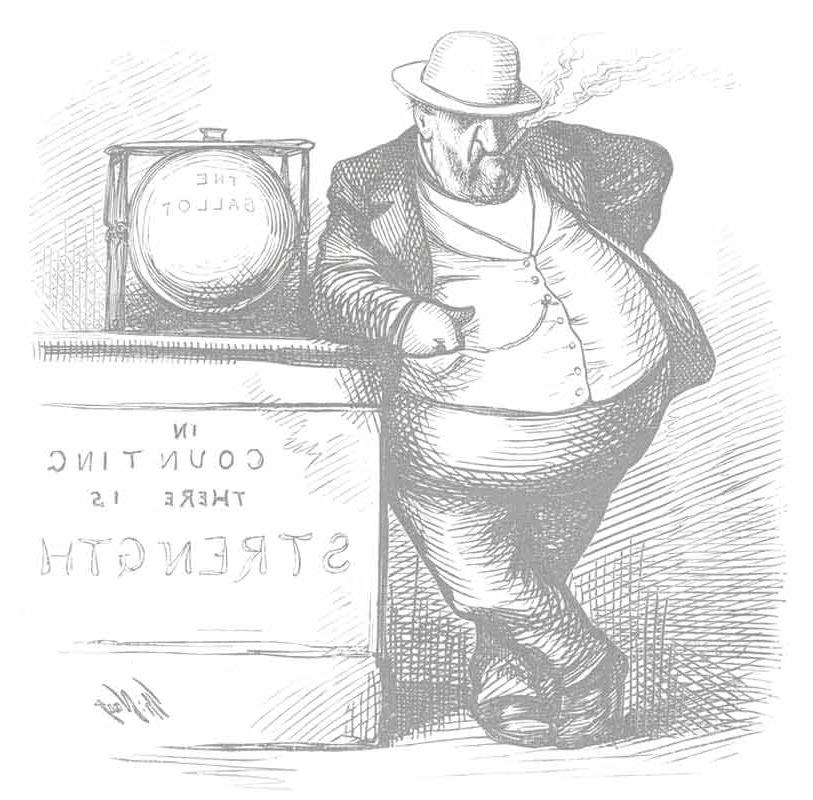






解读政治漫画
政治符号, 种族和民族刻板印象, 思想的拟人化, and caricatures of once familiar public figures abound in 19th-century political cartoons. 在本世纪初, cartoons usually depicted static figures espousing now-arcane political points—and sometimes dreadful puns—in text-filled balloons. 在本世纪后期, cartoons are filled with once-familiar political symbols and caricatures of public figures whose likenesses have faded from popular memory. 种族和民族的刻板印象也很普遍, even in cartoons that express sympathy for the plight of the people or causes represented in them. While some political symbols—such as the Democratic donkey and the Republican elephant—have remained remarkably stable over time, Thomas Nast’s characterization of “Boss” Tweed as a bloated money bag on legs may elude present-day viewers. Explore a selection of cartoons that illustrate some of these elements with brief explanations to help you “decipher” images found throughout the web display.
Thomas Nast drew this cartoon of a ballot box being kicked about as a reference to the contested 1876 Hayes-Tilden presidential election which was decided by an Electoral College commission, 而不是选民的民意.
The 19th-century ballot box was a hand-blown glass bowl contained in a frame to make voting “transparent.他说:“这是为了消除填塞选票的行为, 但它却成了政治漫画中随处可见的象征投票权或, 在这种情况下, 滥用投票权.
化身
Political cartoonists have relied on personification—giving human characteristics to non-human objects and ideas. Over time, figures once frequently caricatured have become less familiar and stock characters in cartoons have been superseded.

“对不起,先生——你知道现在几点了吗??作者:Herb Block——8月27日出版, 1946年的信用额度:1946年的赫布洛克漫画, ©The Herb Block Foundation
在他对"老大"特威德和坦马尼集团的史诗般的远征的高潮, Thomas Nast reduced his repeated caricatures of Tweed to their essence: he portrayed the driving force—the “Brains”—behind political corruption in New York as Tweed’s body with his face replaced by a money bag. In 1871, 纳斯特可以利用这种艺术速记达到极大的效果, as Tweed’s enormous girth and his “radiating” diamond pin would be familiar to readers of 哈珀的每周.
75年后, Herblock (Herbert Block) personified the danger of the nuclear age in the character of “Mr. “原子”——一种具有人类特征的早期原子弹. 1946年7月,就在奥巴马当选前几周. Atom问“世界外交”现在og体育平台时候.S. 曾在比基尼环礁进行原子弹试验. 虽然布洛克并没有打算让特朗普. 在他的漫画中,亚当一直是一个重要的人物, this character made many appearances and became even more ominous with the proliferation of nuclear weapons during the Cold War.
Stereotypes
政治漫画家已经并将继续使用刻板的角色. 刻板印象是识别个人或群体的视觉简写. However, once easily understood references to supposed religious or ethnic attributes can be hard to understand or be deeply offensive to today’s viewer. 19世纪的漫画经常包含负面的种族刻板印象. 即使在提倡公民权利或政治权利的漫画中也是如此, 不管漫画家的意图og体育平台.
Thomas Nast’s progressive views on civil rights and good government were marred by an extraordinary hostility to Irish immigrants (almost always shown as the dupes or violent supporters of the Democratic political machine) combined with an equal or greater anti-Catholic bias.
这张封面插图 哈珀的每周 是阿尔弗雷德·R. Waud. 出生于伦敦, Waud became a celebrated Civil War artist/reporter who documented Black life in the South during Reconstruction. 在这里,他描绘了第一次投票的黑人“代表”, 包括一个穿着打补丁衣服的老工人, 衣着华丽的商人, 还有一位仍然穿着内战制服的前中士.
In 1871, “借用”英国插画家和政治漫画家的一幅画, John Tenniel, 纳斯特抗议爱尔兰移民在纽约的骚乱. He drew a simian-featured Irishman sitting on a powder keg with a rum bottle in one hand—and a lighted torch in the other.
复杂的漫画
The illustrations below are examples of how odd early political cartoons can appear today. They often contain static figures making long statements contained in balloons above their heads or, 更神秘的是, 包括很少或没有解释性文字. 几乎所有早期的卡通片都需要仔细检查, even then, 主题可能仍然难以捉摸.

芝加哥政纲和候选人, Lithograph. 纽约:柯里尔和艾夫斯出版社,1864年
虚伪的乔治·麦克莱伦将军, 据说是路易斯·毛雷尔写的, 他在1864年发誓要竞选总统, 都是为了忠于他的联邦战友 and 作为和平候选人. He stands upon the shaky Democratic Party platform proclaimed at the Chicago convention, 在前线被铜头党政客费尔南多·伍德和克莱门特·L. 瓦兰狄甘,后面是魔鬼和杰弗逊·戴维斯. 左边的爱国联盟士兵“闻到了硫磺味”,” while an Irish immigrant “Peace Democrat” (armed with a club and speaking in dialect) threatens to “knock any man on the head that’ll vote agin” McClellan.

崇拜北方, 阿德伯特·约翰·沃尔克蚀刻的平版摹本. 一幅南方联盟战争蚀刻版画[美国]?:出版商不详,出版于1886-1900年间?]
Adalbert J. Volck, 马里兰州的牙医, 了讽刺, 他在漫画中抨击联邦政府的虚伪和无能的领导, such as 对北方的崇拜. Photography made it possible for Volck to draw fair likenesses of the Union political figures and soldiers that he caricatured. While it is difficult to know how widely Volck’s cartoons circulated during the war, 后来,这些书的再版在南方同情者中流行起来.
In 对北方的崇拜, Volck satirizes a “Chicago Platform” diametrically opposed to that drawn by Louis Maurer—the Republican Party Chicago platform of 1860—as “Negro Worship.” Under the gaze of Abraham Lincoln and lighted by a torch held by Charles Sumner, Henry Ward Beecher sacrifices a chained white man on the altar to a Black slave as Union generals who pressed for emancipation, Benjamin F. 巴特勒和约翰·C. 弗里蒙特(穿着鹿皮),从右边看. John Brown stands on a pedestal armed with a pike—the enslaved people he hoped to lead in revolt were to be armed with pikes—and Harriet Beecher Stowe looks on from the right-hand margin of the cartoon. The altar rests on “Puritanism” and is labeled with a somewhat incoherent list of the moral failings of the North, 包括“自由恋爱”和“社会主义”以及“无神论”和“焚烧女巫”.”
This cartoon is from a set of lithographic facsimiles of Volck’s Civil War etchings printed in Philadelphia in about 1886.




 《og体育官网》,政治漫画,A. R. Waud. From 哈珀的每周1867年11月16日,第721页.
《og体育官网》,政治漫画,A. R. Waud. From 哈珀的每周1867年11月16日,第721页.